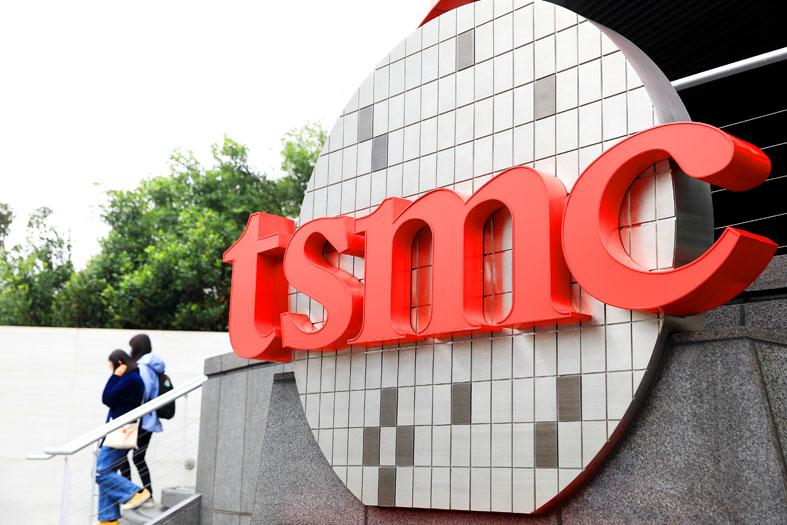Taiwan Semiconductor Manufacturing Co’s (TSMC, 台積電) revenue rose to a record in the first quarter on demand for chips used in smartphones, computers and vehicles, while a prolonged shortage helped to boost prices.
Revenue jumped 36 percent to NT$491.1 billion (US$17 billion) in the first quarter, the company said in a statement yesterday.
Analysts estimated NT$469.4 billion on average.

Photo: Cheng I-hwa, Bloomberg
Demand for mobile phones, smart televisions and other gadgets from makers such as Apple Inc and Samsung Electronics Co remains robust even as consumers in major markets in Europe and the US exit COVID-19 pandemic-era lockdowns and work-from-home arrangements.
Meanwhile, a chip shortage is yet to ease — the wait times for semiconductor delivery grew again last month due to China’s COVID-19 lockdowns and an earthquake in Japan that hit production, research by Susquehanna Financial Group said.
TSMC has kept production running in China, even as many other factories suspended operations to cope with the local pandemic policy. The chip assembler said at the end of last month that it would rearrange production priorities to deal with a shift in demand caused by COVID-19 restrictions in Shanghai and Shenzhen.
TSMC was not planning to revise down its sales and capital spending forecasts for this year, chairman Mark Liu (劉德音) said at the time.
Shares of TSMC have lost about 8 percent this year, hurt by a broader decline in global technology stocks and China’s lockdowns, which have weighed on consumer demand and affected supply chains. The stock advanced 0.2 percent yesterday ahead of the company’s report.
Separately, contract chipmaker United Microelectronics Corp (UMC, 聯電) yesterday said revenue soared 34.66 percent last quarter to a new record high of NT$63.42 billion, compared with NT$47.1 billion in the same period last year.
On a quarterly basis, revenue expanded 7.31 percent, slightly better than the chipmaker’s expectations.
UMC expected revenue to rise about 5 percent sequentially, primarily due to price hikes, citing strong chip demand from makers of vehicles, Internet-of-Things devices and display drivers.
UMC forecast that revenue growth this year would outstrip the foundry’s sector projected growth of 20 percent in a best-case scenario.
Additional reporting by Lisa Wang

GROWING OWINGS: While Luxembourg and China swapped the top three spots, the US continued to be the largest exposure for Taiwan for the 41st consecutive quarter The US remained the largest debtor nation to Taiwan’s banking sector for the 41st consecutive quarter at the end of September, after local banks’ exposure to the US market rose more than 2 percent from three months earlier, the central bank said. Exposure to the US increased to US$198.896 billion, up US$4.026 billion, or 2.07 percent, from US$194.87 billion in the previous quarter, data released by the central bank showed on Friday. Of the increase, about US$1.4 billion came from banks’ investments in securitized products and interbank loans in the US, while another US$2.6 billion stemmed from trust assets, including mutual funds,

AI TALENT: No financial details were released about the deal, in which top Groq executives, including its CEO, would join Nvidia to help advance the technology Nvidia Corp has agreed to a licensing deal with artificial intelligence (AI) start-up Groq, furthering its investments in companies connected to the AI boom and gaining the right to add a new type of technology to its products. The world’s largest publicly traded company has paid for the right to use Groq’s technology and is to integrate its chip design into future products. Some of the start-up’s executives are leaving to join Nvidia to help with that effort, the companies said. Groq would continue as an independent company with a new chief executive, it said on Wednesday in a post on its Web

JOINT EFFORTS: MediaTek would partner with Denso to develop custom chips to support the car-part specialist company’s driver-assist systems in an expanding market MediaTek Inc (聯發科), the world’s largest mobile phone chip designer, yesterday said it is working closely with Japan’s Denso Corp to build a custom automotive system-on-chip (SoC) solution tailored for advanced driver-assistance systems and cockpit systems, adding another customer to its new application-specific IC (ASIC) business. This effort merges Denso’s automotive-grade safety expertise and deep vehicle integration with MediaTek’s technologies cultivated through the development of Media- Tek’s Dimensity AX, leveraging efficient, high-performance SoCs and artificial intelligence (AI) capabilities to offer a scalable, production-ready platform for next-generation driver assistance, the company said in a statement yesterday. “Through this collaboration, we are bringing two

Even as the US is embarked on a bitter rivalry with China over the deployment of artificial intelligence (AI), Chinese technology is quietly making inroads into the US market. Despite considerable geopolitical tensions, Chinese open-source AI models are winning over a growing number of programmers and companies in the US. These are different from the closed generative AI models that have become household names — ChatGPT-maker OpenAI or Google’s Gemini — whose inner workings are fiercely protected. In contrast, “open” models offered by many Chinese rivals, from Alibaba (阿里巴巴) to DeepSeek (深度求索), allow programmers to customize parts of the software to suit their